Memory Performance: 16GB DDR3-1333 to DDR3-2400 on Ivy Bridge IGP with G.Skill
by Ian Cutress on October 18, 2012 12:00 PM EST- Posted in
- Memory
- G.Skill
- Ivy Bridge
- DDR3
Conversion – Xilisoft 7
Another classic example of memory bandwidth and speed is during video conversion. Data is passed between the memory and the CPU for processing – ideally faster memory here helps as well as memory that can deal with consecutive reads. Multiple threads on the CPU will also provide an additional stress, as each will ask for different data from the system. Our test uses two sets of conversions: first, a series of 160 videos have the first three minutes of each converted from various formats (480p to 1080p mkv) to AAC audio; and second is the motherboard testing, converting 32 1080p videos to iPod format. Each test is measured by the time taken to complete.
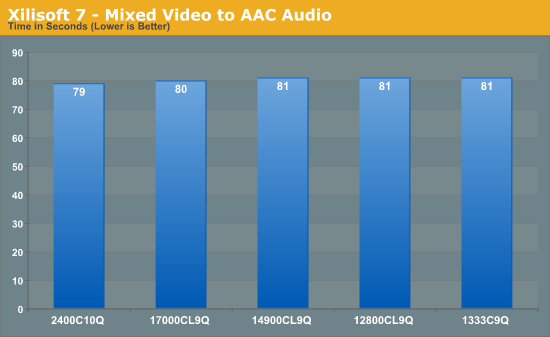
Converting to AAC seems to depend not on the memory – the movement of data from storage to memory to CPU is faster than the CPU can compute.
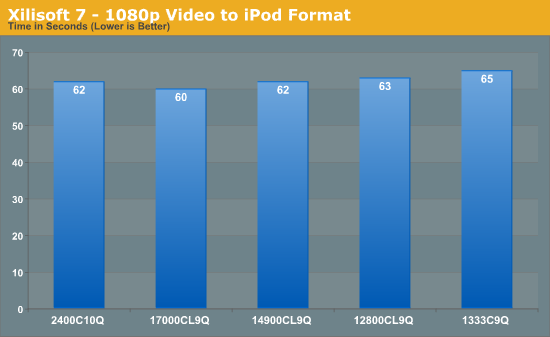
Video conversion is often one area quoted as being beneficial for memory speed, however these does not seem strictly true. As data is moved from storage to memory to the CPU, only if that memory transfer is the limiting factor does having faster memory help. In conversion to an iPod video format, that seems true moving from DDR3-1333 to DDR3-2133 just about, however it seems the limiting factor is still the CPU speed or the algorithm doing the conversion.
Folding on GPU
Memory usage is all algorithm dependent – if the calculation has a lot of small loops that do not require additional reads memory, then memory is unimportant. If the calculation requires data from other sources in those calculations, then memory can either be stressed randomly or sequentially. Using Ryan’s Folding benchmark as a platform, we are testing how much memory affects the serial calculation part of a standard F@H work unit.
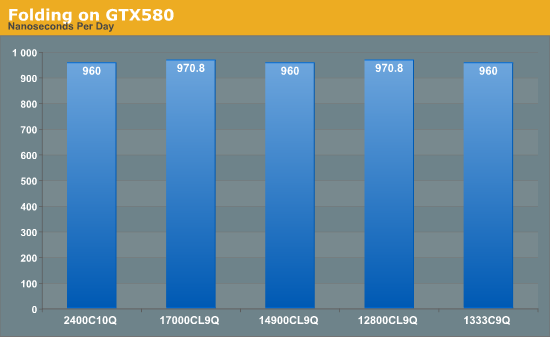
Unfortunately this test is only available to the nearest second, thus the benchmark finishes in either 89 or 90 seconds, giving appropriate ns/day. From the results, folding on GPUs is not affected by memory speed.
WinRAR x64 4.20
When compressing or converting files from one format to another, the file itself is often held in memory then passed through the CPU to be processed, then written back. If the file is larger than the available memory, then there is also loading time between the storage and the memory to consider. WinRAR is a variable multi-threaded benchmark, whereby the files it converts and compresses determines how much multi-threading takes place. When in multithreaded mode, the rate of cache misses can increase, leading to a less-than optimal scaling. Having fast memory can help with this.
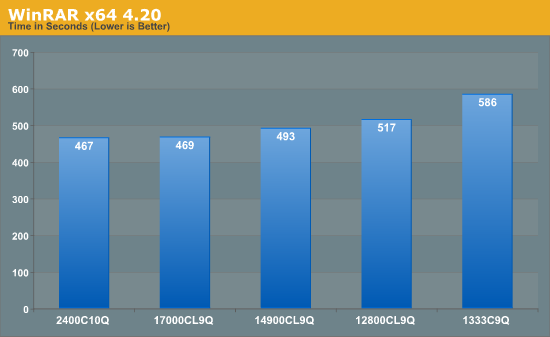
WinRAR is one of the benchmarks in our testing suite that benefits immensely from having faster memory. Moving from DDR3-1333 to DDR3-2400 speeds the process up by 20%, with the biggest gain moving from 1333 to 1600, and noticeable gains all the way up to 2133 C9.
Greysky's x264 HD 5.0.1
The x264 HD test, now version 5.0.1, tests the time to encode a 1080p video file into a high quality x264 video file. This test is standard across a range of reviews from AnandTech and other websites allowing for easy comparison. The benchmark is capable of running all cores to the maximum. Results here are reported as the average across four attempts for both the first and second passes.
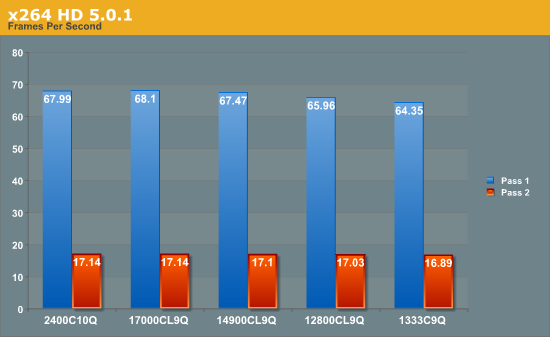
In another conversion test, we see that this benchmark gets a ~5% boost with faster memory, although Pass 1 sees a bigger boost than Pass 2. If conversion into x264 is the main purpose of the system, then the price premium of the faster memory could easily be justifiable.










114 Comments
View All Comments
crackedwiseman - Thursday, October 18, 2012 - link
OK, just one question: why in the hell are the IGP memory tests done on an i7? The results would be much more meaningful if the tests were on an AMD A10 or similar - it has a beefier IGP, and thus would be more bandwidth-bound.creed3020 - Thursday, October 18, 2012 - link
100% Agree. Doing these tests against a Trinity APU would have been much more interesting from a iGPU point of view. It it well known that AMD APUs benefit from increased memory bandwidth, AT has yet to test Trinity for this yet they did it for Llano.silverblue - Thursday, October 18, 2012 - link
It makes sense to test; HD 4000 is far superior to HD 3000 and it is worth knowing if that extra power is bandwidth limited. Generally, it is a little, though nowhere near as much as AMD's equivalents are.JonnyDough - Monday, October 22, 2012 - link
Not to mention, it's surprising to me that AMD wasn't mentioned as a company trying to match memory to motherboard. AMD started making their own memory modules, an interesting fact I think.SeanJ76 - Saturday, June 21, 2014 - link
AMD is a decade behind Intel, in processor technology and instructions, it really doesn't matter what AMD attempts to do....SeanJ76 - Saturday, June 21, 2014 - link
No one gives a shit about APU you moron......these are desktop tests!hp79 - Thursday, October 18, 2012 - link
Maybe because more people use intel? I agree that it would have stood out more if it was AMD's IGP, but doing the test on intel IGP is also okay and gives an idea of what to expect. I think the article is fine. Besides, do people really play games with IGP? If I am playing demanding games, I want the frame rates to be minimum 60 fps. That's why I use a dedicated graphics card. This might change when AMD's IGP gets even more powerful, but for now I think it's still not there yet.zcat - Thursday, October 18, 2012 - link
> Besides, do people really play games with IGP?Some of us do. My miniitx i7 is primarily for work & everyday use, but its HD4000 is fast enough for Portal 2 and Diablo 3 to be very playable @ 1920x1080p with AA off.
However, I know the limits of IGP, and intend on upgrading to an overclocked GeForce GTX 650 Ti very soon in order to play some more demanding games this winter.
sking.tech - Monday, October 22, 2012 - link
you may want to reconsider your choice of video "upgrade"nvidia's 2nd number is more significant than the first as far as overall gaming graphics power goes... You'd do better going for a 560 TI than a 650 for approx the same cost
Dirk Broer - Wednesday, July 24, 2013 - link
You should first look at what chip actually powers the card -and it's capabilities- before staring yourself blind on the last two digits. Besides that, a GTX 560 Ti is more expensive than a GTX 650.